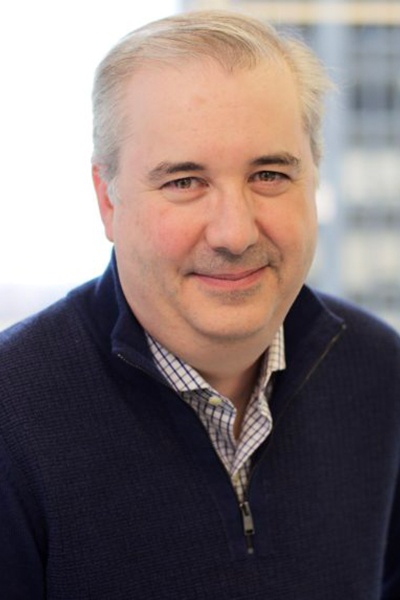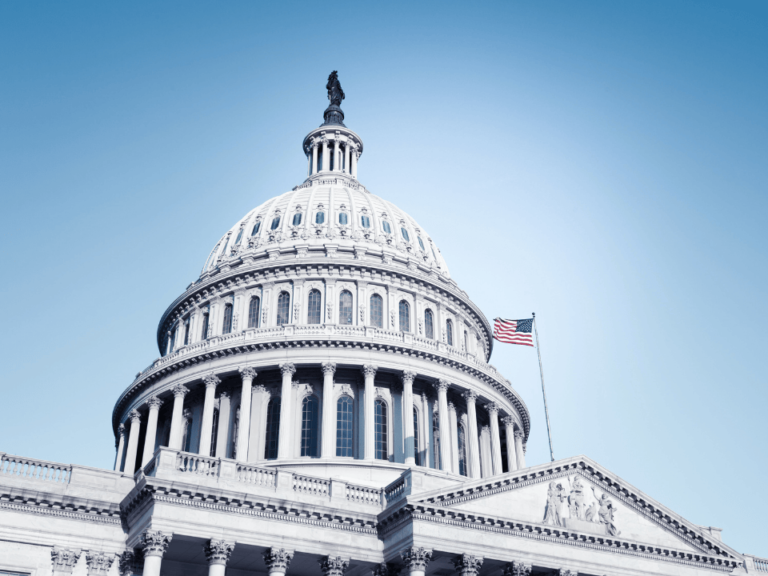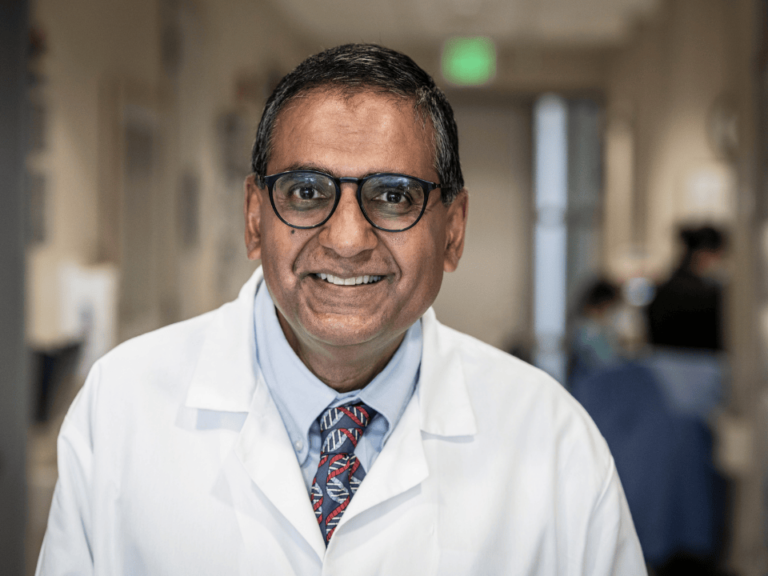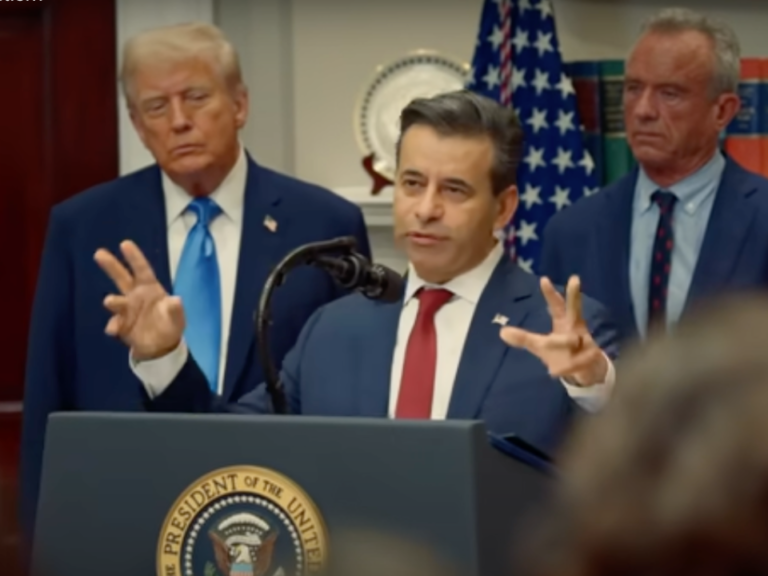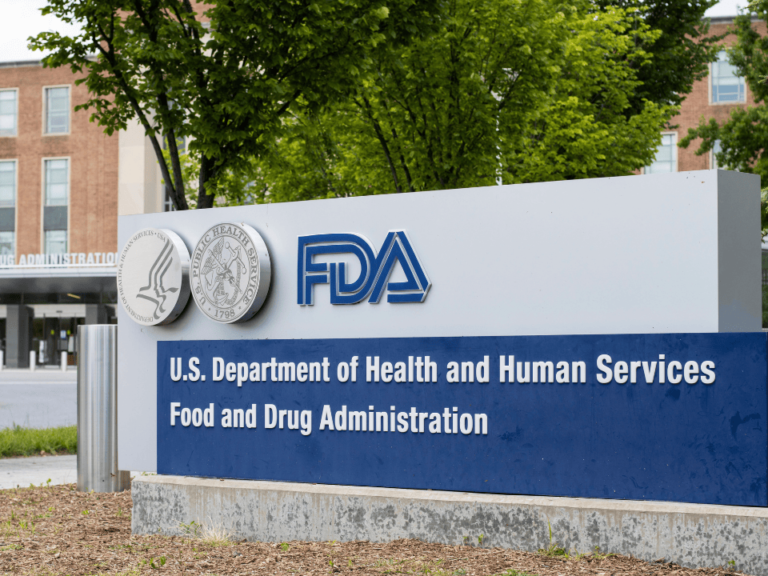Raymond N. DuBois has joined The Mark Foundation for Cancer Research as executive chairman of the board.
Concurrently, The Mark Foundation announced that its founder Alex Knaster has committed to funding an additional $500 million to cutting-edge cancer research.
DuBois is director of MUSC Hollings Cancer Center and a Distinguished University Professor.
Alex Knaster, chairman and CEO of Pamplona Capital Management, established The Mark Foundation in 2017 to support pioneering research with the potential to transform the next generation of treatments and diagnostics.
“Alex has wanted to continue and accelerate his support, even before I got on the scene,” DuBois said to The Cancer Letter. “The track record for the foundation’s been spectacular. And, as you’ll see, when you look at the portfolio, the projects and the scientists are really advancing the field. So, I think he’s been happy with that, and really, wants to have as big an impact as possible and realizes that more money would do more.”
So far, the foundation has made over 200 grants, awarding $150 million have been awarded to individual scientists and teams at more than 80 academic institutions in the United States and internationally.
“We try hard to bring people together around topics. We bring experts together from different fields,” Schoenfeld said to The Cancer Letter. “We look across fields, we look at the interdisciplinary interfaces between fields, where we can bring people together. We look at the interfaces between industry and academia and try to bring people together who have common purpose to get new drugs and therapies and diagnostics to patients.
“There’s a lot of good academic discoveries that have been either left behind or moved forward much more slowly than they needed to be. So, I’m interested in how we can be helpful to accelerate these things, going forward.”
The Mark Foundation’s grant programs include:
- ASPIRE Award,
- Emerging Leader Award,
- Drug Discovery Award,
- Endeavor Award,
- The foundation has established three Mark Foundation Centers to support large-scale team science research at University of Pennsylvania, Johns Hopkins University, and University of Cambridge.
- The foundation has also made investments of $20 million in seven oncology-focused companies.
DuBois and Schoenfeld spoke with Paul Goldberg, editor and publisher of The Cancer Letter.
A video recording of the conversation is available here.
Paul Goldberg: Well, gentlemen, thank you so much for agreeing to talk with me. I guess my first question is going to be to Ray, because you’ve been involved in funding of cancer research for a very long time, from very many venues, such as NCI, of course, as a reviewer and the center director. Also, CPRIT, also Stand Up To Cancer, and I’m probably missing something.
Raymond N. DuBois: Paul, this is something of a passion of mine. I’ve really wanted to help do whatever I can to make sure that cancer research gets funded, and obtain more support for these kinds of projects. I’ve also been involved with the Kleberg Foundation in Texas.
And so, all the way up from just putting out the RFAs, reviewing the projects, and thinking at a little bit higher level about strategy and the role at The Mark Foundation. There is a very well-established portfolio of different grants for young researchers, mid-level researchers, and then also for well-established researchers.
There’s also funding for these virtual centers that Ryan can talk about. But what we want to do is really fund the most cutting-edge science that’s going to have the biggest impact. We don’t always know what that is, but I think there’s a process in place that’s been successful. Ryan and I are thinking about how we can fine tune that, and just make sure that those important cutting-edge projects get funded, so that we can accelerate the discoveries and get these findings into the clinic.
Thank you. Ryan, you’re come in by way of industry, of course. And could we talk about your vision and how your background fits into all of this? And how it drives it?
Ryan Schoenfeld: Absolutely. You’re right, I come from industry. I spent most of my career working in pharmaceutical R&D groups, in the field of drug discovery for oncology and for other diseases. And the thing that I really realized while I was in industry was, I always thought about, “Where do these projects we’re working on come from, right? How do we decide we want to make a drug that does X, Y, or Z? Or, targets these pathways?”
Inevitably, I always reach back to academic discoveries of one type or another. And we were always looking for new targets and new ways and new approaches, because the existing drugs have their limitations, and the existing approaches have their limitations.
We were always trying to look for what was new. To be competitive with the other companies, but also to really, to benefit patients, to bring something that works better to patients.
And so, I feel like, the bridge between academic research and what happens in industry to scale out drugs and therapies and diagnostics to reach patients in a large way, there’s a lot of challenges in bringing discoveries forward from their academic starting points to ways that they can reach more patients.
And so, I really got excited about working on the academic side more, in helping facilitate some of these projects with funding, but also with access. It’s not just about funding for what we do here at The Mark Foundation. We try hard to bring people together around topics. We bring experts together from different fields.
We look across fields, we look at the interdisciplinary interfaces between fields, where we can bring people together. We look at the interfaces between industry and academia and try to bring people together who have common purpose to get new drugs and therapies and diagnostics to patients.
There’s a lot of good academic discoveries that have been either left behind or moved forward much more slowly than they needed to be.
So, I’m interested in how we can be helpful to accelerate these things, going forward.
So, it’s early science and it’s team science, is what you’re thinking, and it’s also crossing from academia to industry. But how does it actually work? How does the rubber meet the road, gentlemen?
RND: Well, Paul, there is a venture philanthropy component that Ryan can explain. But there are certain projects that are a little bit further along, that you need some support to get closer to the finish line. And so, there is a component of that, at The Mark Foundation as well.
Ryan?
RS: I’ll say a little about our venture side, but also to address the question, with a different aspect of what we do. We really focus on translational. I mean, we started the foundation focused on translational science and really, that means, right, taking discoveries into the clinic. And sometimes, that needs to be industrial, because it costs a lot of money. And so, you need to get some bridge to get things from academia into the industry to help pay for that. Other times, it may not be the case.
Maybe something can go forward in the clinical setting, without money from big pharma, at least to a certain point. So, we’re always looking for, what would be the biggest impact of funding, right?
We’ve given $150 million in grants, the last four and a half years. And we give grants and these are to move science forward, either by individual investigators, or teams, move things forward to the next inflection point, help de-risk things, that would otherwise be too risky to become their own venture, to spin out if they were going to become a new company, or go into the clinic in any other way, that would require people to put more money into them.
So, we are always looking at that space. We don’t limit ourselves to the translational domain. We look at things earlier in the discovery stage, or basic research stage.
We do fund some things in the clinical stage, but often we feel like, that’s the space where other people, with deep industry pockets could take things forward to a pivotal clinical trial that requires 1,000 patients and 100 sites, or something. We’re not looking to fund those either. We’re looking to be catalytic, be accelerative and to help move things forward through that translational space.
And so, when it comes to investing, we do that, in a way that a discovery that we’ve either helped, or someone else has even helped, it doesn’t have to be limited to our grants, if the way that we can help some science get into the clinic and potentially, reach more patients, if it’s successful there, sometimes that requires spinning out into a venture where you can get other investors to put some money in as well.
And we will help seed that. We’re almost never the lead investor, we’re typically a part of a syndicate, but we will often be the first investor, and we’ll help de-risk the investment for other investors, who may want to join us and even go in in a larger way than us and help move something forward.
Well, how much money is involved? It’s, more than $150 million. It’s $500 million.
RS: It’s $500 million going forward. So, $500 million’s the future. So, $150 is the retrospective.
So, this is an acceleration?
RS: Yeah, exactly.
You’ve accelerated. So, it’s $500 million going forward. And how does one apply? And what will it pay for?
RND: Paul, that information, is really well outlined on the website. There’s a lot of details with the explanation of the different awards, Aspire, Endeavor, and those kinds of things. So, Ryan can run through that, but the real nitty gritty of how to get that application in and everything, I think it’s well described on the website.
And unlike the Break Through Cancer Foundation that you previously interviewed Tyler [Jacks] on, we are supporting all types of cancer research, not just, the most deadly. And so, we’re open to looking at all solid and hematologic malignancies, and all types of cancer.
Well, I’m sure people will find the website, now that they know it’s $500 million. It’s probably worth their while to take a look and see if they might just have a project somewhere out there. I guess, I should probably ask about peer review, because these organizations are as good as peer review, as we’ve all seen many times over.
RND: Well, there’s a scientific advisory board. It’s got some names on there that you would recognize, from your working at The Cancer Letter and by that group, some are reviewed in-house, and the lower-level awards, I think Ryan and the team there, there’s a team of PhD scientists at the foundation, who manage the portfolio and they get involved in some of those early reviews. So, Ryan, you want to review that with Paul?
RS: We have a scientific advisory committee chaired by Ross Levine and they work with us on a number of our grant programs. But, we have about five different grant programs that we do, and they all have peer review, all of them. And then, they have different flavors of it. So, some of them, we will create year-to-year, a bespoke review committee for that particular award program.
Often, we do that for flexibility, a given RFP, request for proposals, will happen around a specific focused theme; right? For example, we did a workshop in 2020, and then we had a call for proposals, on chemically induced proximity, which is a chemical biology theme. It’s a very active area of research these days in cancer and elsewhere.
And so, we had a review committee comprised of experts in that field, who did not apply for the grant. And then, we have other people who applied for the grant. And so, we were able to create bespoke panels fit for purpose of experts.
Other programs are more, as Ray mentioned, we’re open to every type of cancer research, so some of our award programs like our Emerging Leader Award, where the RFP is going to open very soon, that’s for any type of cancer, you can propose anything. And so, we have a panel of 12 experts who have worked with us year-over-year. And we select them, they’re all leaders in their respective sub-fields within cancer research, but we cover a lot of different ground.
There are folks who have a genomics and genetics background, folks who have a chemistry background, folks who have a data science background, folks who have a pathology background, model systems, translational science.
So, we like bringing people together who have these interdisciplinary backgrounds, and we find there’s a lot of energy in the room, when groups like that get together to discuss new ideas and new projects. And so, most of our committees have some flavor like that.
Is there a connection between Ray stepping in, and the $500 million?
RND: Well, I think that Alex has wanted to continue and accelerate his support, even before I got on the scene. So, I can’t take any credit for that. But I think the timing is good. The track record for the foundation’s been spectacular.
And, as you’ll see, when you look at the portfolio, the projects and the scientists are really advancing the field. So, I think he’s been happy with that, and really, wants to have as big an impact as possible and realizes that more money, would do more, basically, going forward.
How quickly will the spend take place of the $500 million?
RND: That’s a good question. Ryan, and I haven’t talked about that. But, we’re not going to just throw it out there. We want to make sure that the projects have high merit and deserve the funding that we want to provide. So, we’re really looking for the top science. And so, I guess it depends on how much of that we see and how those applications look. But, we haven’t been given a time limit, as far as I know.
Oh, fascinating. So, you can do it in a year? You could do it in 10?
RND: I think that would be difficult.
RS: That would be hard. The approach we were just talking about, in terms of our approach to peer review, we want to maintain that; right? There’s a lot of work that goes into building those networks and getting that done. So, we want to keep that. So, it will require some pacing, I think, to do this. So, I think we’re looking over the next half decade, I mean. But, it’s not anything that’s been mapped out in detail, yeah. So, we’ve been around for about five years. So, we’re looking at the next five years, really, I think, that’s the lens we’re looking to use.
Who owns the intellectual property? Who owns the discoveries? Is it the foundation? Is it the people who make the discoveries? And, don’t you also invest some of the money?
RND: There’s a small percentage of those kinds of investments, but in the group of projects that are underway, we don’t demand all the intellectual property. But, sometimes, there are opportunities for the foundation, and they take advantage of it.
So, what were some of the ones that you’ve done? I think, I know of one. What have you invested in? Which- projects?
RS: Yeah, I think that we’ve made six investments. One, you may be aware of, is in GRAIL, our first investment. In 2017, we invested in GRAIL and that was recently acquired by Illumina. And that was in very early days of The Mark Foundation.
We really believe in liquid biopsy, as a potentially transformative technology for cancer early detection. Part of that was impact-based, actually. GRAIL was raising money to fund a study, to look in nasopharyngeal cancer in particular, using liquid biopsy to fund an additional clinical study, that extended their Series B.
It’d be a shame if we waited five years for you to scrap together here and there on the side, the preliminary data, you would need to justify it. We want to hear about those ideas now, and maybe talk about ways we could help catalyze them, de-risk them, fund some of that now, get you started earlier.
Ryan Schoenfeld
We did it to invest, with a return that would help grow the foundation, but also for impact. The rest of our portfolio, we’ve invested in since then, a mix of ventures, some that have spun out with IP from our grants.
One example is, C2i Genomics, which is another liquid biopsy company, but they have a different approach where they’re looking at minimal residual disease and doing liquid biopsy in a different way. And that’s something where we gave that team a grant. That grant was catalytic to get them some clinical data that they could then use to help raise some funding and to start and launch a new company.
And they’ve had a very successful Series A and Series B in the last two years, and they’ve done very well, and things are going well there. And then, another example is a company called Interius [BioTherapeutics], which one of our emerging leader award grantees started as a cell therapy-focused company. It’s an in vivo CAR T-focused company.
Other companies we’ve invested in, such as Accent Therapeutics have not been linked to our grants, they’re linked to areas of biology that we are passionate about.
In that case RNA-modifying proteins, right, this is an area that we feel is an emerging field. We felt that, this company was taking good risks to move some really interesting projects forward in their portfolio.
And so, we have a full-time venture principal, who really treats this with a professional approach to investing, although the difference between us and a venture capital firm is that any returns come back to The Mark Foundation and stay in the foundation, and we can use those returns down the road to give grants and things like that.
So, what’s the percentage that you’re putting in to venture? So, of the $500 million, how much can go to venture?
RS: Well, there’s not a limit. We expect some of that to have a return. In the last four and a half years, we’ve given $150 million in grants and $20 million in investments.
Got it.
RS: So, that ratio may grow a little bit. I think our investment, the growth and maturation of the investment side, is coming up a little bit, alongside the grants now. So, that ratio may increase a little bit, but I think, that’ll give you some sense of where we would look to keep things, as a percentage, maybe in the four to one, five to one range.
But, over time; right? We expect these to give returns. So, we still think we’ll be making $500 million in grants, even though we’ll be making a substantial number of investments, because we should get some returns. If we don’t, that’s okay. But we’ll be careful not to put too much in the investment basket, just in case. But we’re hopeful to get returns and growth from there as well.
Yeah. But, with GRAIL, you must have made some money.
RS: We did, we did. And we hope to repeat that, and yes, yeah.
So, that wouldn’t be a bad thing to do. Is there anything we’ve forgotten? Anything I forgot to ask? Anything we missed?
RND: Well, Paul, in addition to the investments and Alex’s support, there have been some donations to just generally, support cancer research. So, the foundation does accept those. It’s not been a big focus so far, but that’s another potential avenue for the future.
Anything else we’ve forgotten? Anything you might want to just say to people who might be considering applying for a grant? What are you looking for?
RND: It’s not a secret. We want to fund the best science possible. So, it is a fairly competitive process. And the foundation has gotten applications for each round of these, but one soft spot is we love to support early investigators, and at a time where it’s critical for them to really, get on a steep trajectory. So, for example, when somebody gets their first R01, they’re locked into that research and those specific aims that they’ve got to do.
If they have something on the side, they would like to explore, that could be exciting, it’s difficult, unless they get some additional support from a foundation, or their startup funds, or whatever. So, we really have a keen eye towards trying to figure out those particular folks, because we want to make sure we have a next generation of scientists and physician scientists and basic scientist to keep doing this research. And so, if we can add a little fuel to that, that’s going to really allow them to make some headway in a very positive way, I think that factors in.
Ryan, anything we’ve forgotten to say?
RS: Yeah. I would echo that. We really do want to support young investigators, investigators who are taking risks. I think, we really want to support folks who are… We want to hear about your idea. It’s a really good idea, but it’s not going to get readily funded today by the normal mechanisms.
But it’s something that, it’d be a shame if we waited five years for you to scrap together here and there on the side, the preliminary data, you would need to justify it. We want to hear about those ideas now, and maybe talk about ways we could help catalyze them, de-risk them, fund some of that now, get you started earlier, and do that on the individual scale.
And also, on the team scale, we have an approach to teams. I want folks to think about team science as well, when they think about The Mark Foundation, that we have a number of programs.
The Endeavor program is one in particular that we launched last year, and we’ll have another round of this year, that are focused on teams. And we want the same thing there. We’d love to see junior investigators as parts of these teams.
We’d love to see people who are taking risks. And I know it’s cliche to say high risk, high reward, but we feel like we’ve put mechanisms in place. It’s not easy to actually find and fund those projects. And that’s what we’re really trying to do.
That’s why we have a small staff here, of 10 people, 70% PhD scientists, who spend most of our time, really, just trying to find those projects and programs that truly are the high risk, high reward projects. And try to realize the impact of funding by pointing our resources that way.
For investigators and teams, I mean, that are thinking a little bit differently and looking to take risks in cancer research, looking to work across fields and disciplines, and to try to do something new. Those are the folks who we want to hear from.
And I should emphasize, it’s global. We’re based in New York, a lot of our grantees are in the U.S., but a quarter of our funding today, goes outside the U.S. And there are no structural limitations for us to go out beyond the U.S. And so, we’re interested in just, wherever we can find these projects around the globe, we’re looking to fund that.
Oh, I didn’t realize, it’s global.
RND: So, Paul, we’ve partnered with Cancer Research UK, to make the funding level higher, when both sides put in some support. And also, we’re open to partnering with others to make the research go further. And that has happened in a couple of instances as well.
That’s fascinating. Well, there’s some great opportunities out there. What about any new mechanisms of funding? Anything? Any new programs you have in mind, that might be happening now that Ray’s there and $500 million is there?
RND: Well, Ryan and I are bouncing some things around. There’s nothing really ready for prime time, but people should stay tuned, because we do want stay very innovative and on the cutting edge. And there’s always different ways to support individuals.
And so, we’re not opposed to thinking about that. I’m not saying we’re going to start anything tomorrow, and the foundation’s already been bouncing some interesting ideas around. But, you’ll hear about later.
Well, I’m certainly going to wait. What about public policy advocacy? Are you thinking of that? Not so much public policy as advocacy for research. Is that something you see a role in? For example, if I have a question, can I call you about the subject?
RND: You have to call Ryan about that.
I’ll call Ryan.
RND: I’m just kidding, I’m just kidding. That has not been one of our major foci. We’re really bench science, translational science, some clinical science, and moving that components forward. But, I don’t know. Ryan, have you thought about public policy?
RS: I thought about it a lot, actually, but that’s not the space that we’ve spent a lot of time trying to make a difference in. We care about it and we try to stay up on it. But, I think, a little bit last year, we were interested in the impact of COVID on funding. We were very concerned for our researchers and the research community at large, what the impact of lab shutdowns meant.
We realized that, as much as we are able to give some nice grants, that the majority of funding still comes from other sources. And we were aware of some of the challenges that I think, the COVID situation was creating for access to funding from those other sources.
And so, we were very interested in the policies that are being shaped to address that, at different levels in the community and in governments and things. So, we’ve weighed in with our thoughts from time to time in favor of just trying to make sure folks don’t forget about cancer research, it’s really important.
And not at the expense of research in COVID. We think that’s obviously important too. So, we’ve been a voice for that. And that’s probably about the limit of our policy efforts, is to really just contribute our voice to that, to make sure that folks don’t forget about cancer, because it’s not going to forget about us.
Well, that’s exactly what my question was, and thank you for answering it. Well, thank you so much. One last chance for anything we might have forgotten.
RND: Well, thanks so much, Paul, for taking the time to do this. And for those of you out there, that are really interested in the foundation, I just would encourage you to google The Mark Foundation for Cancer Research, it’ll come right up. It’s a beautiful website. It really describes what we’re doing and anything that we’re going to announce going forward, will show up on that website, so they can check in from time to time.
And, hopefully, the cancer community will pay attention to what’s going on and seek support from The Mark Foundation.



